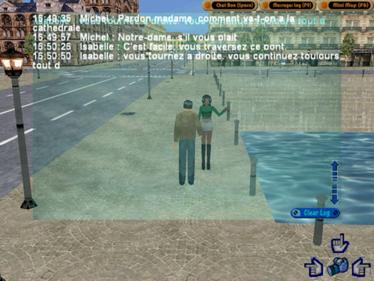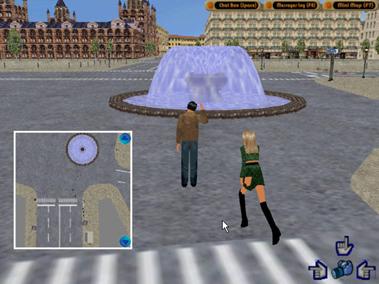Networked Virtual Environment (NVE)
Demo videos (Click to download)
● Version@2001
● Version@2002
Studies of the multi-user virtual reality system have
become a popular topic in the computer graphics community
over the years. World Wide Web (WWW) provides a
seamless, browsable and boundless way for the user
to view and retrieve information from the Internet.
Integration of the multi-user virtual reality environment
into the WWW environment provides a richer way for the user
to access the network resource over the web environment.
The researches on the multi-user virtual environment can be classified into two categories: network-based and web-based virtual reality systems. The first category of the multi-user virtual reality system does not necessarily comply with the architecture of the WWW environment. This type of virtual reality system generally focuses on providing a large scale multi-user virtual environment with every available network technique. On the other hand, the web-based multi-user virtual reality system emphasizes on providing multi-user virtual environments on top of the existent WWW environment.
In addition, the Virtual Reality Modeling Language(VRML) is an attempt to deliver a virtual reality world into the WWW environment. The original goal of designing the VRML is to allow multiple participants to interact over the WWW environment. That is, virtual worlds are networked via the Internet and hyperlinked with the WWW environment. Due to the development of the VRML, the research on the distributed multi-user virtual reality system has been a popular topic in the past few years. However, since the WWW environment is a client/server architecture that is composed of various server sites to form a global database web over the Internet, the communication protocol needs to be designed to achieve the interaction among distributed web browsers.
We developed the first version of a Web-based NVE system, called SharedWeb, in 1998. The main techniques of the SharewdWeb system includes adoptingDIS(Distributive Interactive Simulation) protocol and Dead Reckoning algorithm to provide multiple participants interaction, and Common Gate Way(CGI) with LTP-UID technique to tightly integrate NVE with Web environment. The snapshot of the SharedWeb UI is shown below.

The SharedWeb system was further enhanced for the e-learning application in 2001. Based upon the studies of the legacy e-learning systems, we proposed to adopt the NVE system as the extracurricular practical training environment for the e-learning application. That is, after students learning their courses from the whiteboard-based video e-learning system, they can further practice the courses’ knowledge in the NVE environment. To achieve this goal, the SharedWeb system was enhanced based upon the course requirement. Furthermore, since the e-learning course was French language, the scenario of the SharedWeb system was France restaurant, bookstore, and Notre Dame de Paris. The following is the snapshot of the first-year achievement. During the first year project, the research goal was focus on the UI to trigger the animation of avatars inside the restaurant scenario. The users can play the roles as the waiter or customer. When he is the waiter, his function is restricted to service dishes. On another hand, when he is the customer, he can wave the waiter and order foods.

The second year was the study of a game-like environment to enlighten the learning curve. The scenario of this year was a tour to Notre Dame de Paris as depicted below. A transparent chatting board and a stealth view map were designed to the system to study if students can easily immerse in the scenario.


[Related Publication]
● J. Y. Huang, C. T. Fang-Tson, and J. L. Chang, "A Multiple User 3D Web Browsing System", IEEE Internet Computing, Vol. 2, No. 5, Sept/Oct 1998, pp.70-80. (EI, SCI) (pdf)
● J. Y. Huang, C. T. Fang-Tsou, J. L. Chang, A. J. Lee, "SharedWeb - A Shared Virtual Environment over World Wide Web", The Journal of Visualization and Computer Animation, Vol. 9, No. 3, July-September, 1998, pp.163-182. (EI, SCI)
網路虛擬環境
展示影片(請點選下載)
● Version@2001
● Version@2002
虛擬實境(Virtual Reality)是將現有之聲音、影像、繪圖、文
字等技術加以整合與改良,成為一種人與機器溝通的新媒體與新介面,藉由電腦所整合之虛擬場景與互動式回應方式,讓使用者更能真正
有「身歷其境」的感覺。隨著網路的盛行,人們開始試著結合網路與虛擬實境之技術,因此“網路虛擬實境(Networked VR)”之發展漸趨盛行,許多建構在網路上之模擬演訓、網
路對玩遊戲等如雨後春筍般的發展起來。隨之由於全球資訊網路(WWW)的
普及與流行,有許多人開始著手於虛擬實境與WWW之間的整合與研究,進而發展出虛
擬實境描述語言(Virtual Reality Modeling Language,
VRML)語言更締造了三度空間在WWW應
用領域的另一個新紀元。但是由於VRML經歷1.0與2.0版
的規格以來,對於多人互動的方面還是有相當多的問題有待解決,因此在WWW上
發展多人互動式環境系統還仍屬於方興未艾的討論課題。
在現行網路上發展虛擬實境多人互動系統的方法可分為直接在網路上架構之系統,與透過WWW系統來建構多人互動系統兩種。直接在網際網路上架構多人參與虛擬實境系統又 可分為“主從式(Client/Server)”與“分散式(Distributed)”兩種。主從式網路虛擬實境系統常見應用於網路上的電 腦遊戲,此類技術已發展多年,優點是發展容易,缺點則為同時上線人數有限。分散式多人參與虛擬實境系統則以美國國防部的DIS技術為最成功且標準化的技術,美國曾成功的聯結一萬個模擬個體在網際網路上 同時進行模擬演訓。
透過WWW系統來建構多人互動系統則是試圖藉由WWW環境的方便性來讓使用者可以輕易的加入一個進行中的虛擬世界,同時希望藉由WWW環境的超媒體特性來豐富網路上的虛擬世界。但是目前架構在WWW環境上的多數虛擬實境系統並沒有與現有的WWW環境緊密結合,其多人互動伺服器是完全獨立於WWW伺服器的系統,例如Sony公 司所發展的Virtual Society系統及Blacxxun公司的Virtual Community系統即為明顯的例子。
黃俊堯老師帶領研究生在1998年 設計完成一套與WWW環境緊密結合的多人參與虛擬實境系統,稱為SharedWeb,而此系統已取得國內及美國專利。SharedWeb系統的設計目的是在現有的全球資訊網(WWW)環境上提供一個多人互動的大型虛擬環境,在此虛擬環境下,使用者除了可 以與其他使用者直接產生互動與交談外,同時也可以相互存取全球資訊網所提供的各種超媒體文件。SharedWeb系統採用了兩項重要技術,一個是DIS(Distributive Interactive Simulation)所 定義的Protocol Data Unit(PDU)資料格式及Dead Reckoning演算法。
SharedWeb系統使用的另一個重要技術是Common Gate Way(CGI)程式以及LTP-UID方法。此技術使得多使用者伺服器可以與全球資訊網伺服器緊密結合, 同時保持每一個使用者在虛擬世界內具有唯一代號。透過此技術,多使用者伺服器可設計成全球資訊網伺服器的外掛程式,使得使用者在 下載完虛擬場景之後,可立即使用HTTP協定向多使用者伺服器註冊加入虛擬場景, 而不需等待WWW伺服器另外送多使用者伺服器位址資料給使用者。下圖為SharedWeb系統的電腦畫面之一。

民國90年SharedWeb系統進一步被運用於網路教學方面的研究,與淡江大學法文系合作 向教育部的提昇大學基礎教育計畫提出一個名為”整合網路科技資源運用於多語言虛擬教 室之教學系統 — 以法文為例”的之三年期整合型計畫,該整合型計畫的目標是要以法文教學為例來研究建構網路學 習教室所需之技術,並實際建構相關系統。該整合型計畫希望提供一個可實際運作的虛擬網路法文學習教室,針對不同程度的學習者, 如:初學者、在校生、及進修者,提供合適的法文線上學習資源。因此,該計畫分為三個分項計畫,分別為:
● 分項計畫一:法文網頁資源的分類搜尋與專題製作
● 分項計畫二:多語系的虛擬互動環境研究
● 分項計畫三:以法語系為基礎之遠距教室
該整合型計畫希望在網路環境建制虛擬情境法語教室的網路教學模式,如同傳統上課方式,所欲模擬的虛擬情境法語學習環境分為課堂教學、課外練習、以及課後複 習三個學習步驟。其中
課堂教學:(分項計畫三)利用 多媒體同步控制,以精美圖片與精簡課文製作的簡報,搭配聲訊與視像教學的互動之教學影片,模擬真實教學的情境。
課外練習:(分項計畫二)以三 度空間虛擬場景與人物,引導學生融入課文情境,進行角色扮演的互動式對話練習,以達寓教於樂之目的。
課後複習:(分項計畫一)利用 張網式的架構理論,搭配課文主題相關的網路資源內容,製作專題報導與相關網站連結,延伸學習之空間。
由下圖可看出三個分項計劃的整合關係,而黃俊堯老師即負責分項計畫二,也就是建構一個法語環境的戶 外實習虛擬環境。在該分項計畫中,黃俊堯老師將網路虛擬實境系統定位於法文教學的『戶外實習』功能,配合著第三分項計畫的電子白 板及隨選視訊功能作為課堂教學系統,本分項計畫提供學生在網路虛擬世界內進行課後實習的機會。

在第90年(第一年)執行 期間,按照分項計畫三的教學內容,黃俊堯老師帶領學生建構一個如下圖所示的虛擬餐廳來讓上線學生練習會話,藉由SharedWeb系統的功能,使用者不僅可以與其他使用者進行虛擬動作的互動及 文字交談,並且可以透過WWW環境來相互傳遞網頁形式的菜單及會話提示。

(展示影片)
學生可以在系統上線時,指定要當侍者或是顧客,此時畫面中間的模擬動作啟動視窗就會有所不同,侍者的動作包括提供菜單、上菜、提供飲料、及給帳單等動作, 而顧客的動作(如上圖所示)包括 開門、坐下、站起來、呼叫侍者、及吃東西。而侍者與顧客之間可以透過畫面下方的聊天是來對話,而為彌補虛擬實境系統的限制,本系 統借用畫面右方的HTML視窗來展現模擬物件的細部資料,包括菜單、帳單、菜色、及飲 料。由於此項利用虛擬實境技術來豐富網路教學效果的設計方式與一般的網路教學系統不一樣,因此在該年度的結案報告會議上,引起與 會學者及教育部專員的重視,要求本計畫團隊持續進行此研究,並嘗試設計不同的課程內容來加以驗證成效。
在本計畫的第二年(91年),分項計畫二更進一步加強系統功能及擴大所模擬的場景,延伸至如下圖所示的法國 巴黎聖母院,以旅遊為主軸讓學生能用虛擬的方式體驗到巴黎聖母院旅遊的情境,並且透過一些提供的機制在虛擬世界內進行互動。


(展示影片)
在91年所製作的網路教學虛擬實境系統中,使用者之 間的聊天方式改以採用目前最受歡迎的天堂遊戲軟體畫面重疊技術,使用者的聊天內容以透明白板方式重疊於3D虛擬場景畫面上,使用者登入後,可輸入暱稱及選擇人物類別,共有「男、女居 民」及「男、女遊客」可供選擇。由於本年度所提供的場景比上一年度的場景還大,為避免使用者在練習過程迷失方向,本年度系統提供 了縮小地圖重疊顯示於3D虛擬場景畫面上,使得使用者輕易得知目前他是 在虛擬場景的哪一個地點。
[相關論文]
● J. Y. Huang, C. T. Fang-Tson, and J. L. Chang, "A Multiple User 3D Web Browsing System", IEEE Internet Computing, Vol. 2, No. 5, Sept/Oct 1998, pp.70-80. (EI, SCI) (pdf)
● J. Y. Huang, C. T. Fang-Tsou, J. L. Chang, A. J. Lee, "SharedWeb - A Shared Virtual Environment over World Wide Web", The Journal of Visualization and Computer Animation, Vol. 9, No. 3, July-September, 1998, pp.163-182. (EI, SCI)